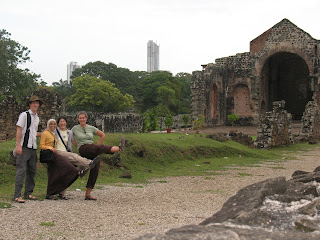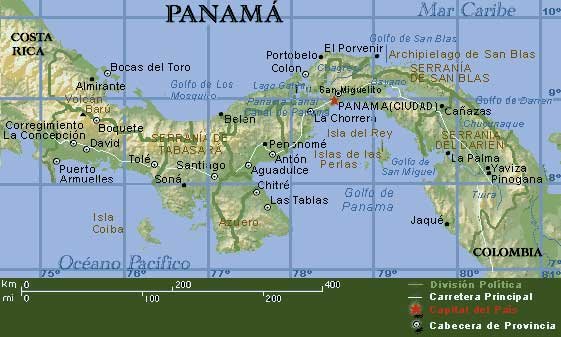 (Tabassum and Kevin in the boat to the island on Christmas Eve)
(Tabassum and Kevin in the boat to the island on Christmas Eve)Q1: How was Panama what you expected?
Well, I think it was definitely the temperature that I expected, with the poverty level and infrastructure that I expected, although at different points I was very surprised by the layout of the land. I expected the mindset of individuals to be more laid-back, and was not disappointed to find a simpler way of life overall, especially within the island community. I also expected food to be cheap, and was not disappointed! :)
Q2: How was it different than what you expected?
I was amazed to orient myself from East to West instead of North to South, because the landscape seemed so diverse, with mountains in the middle of the country and shoreline at the edges. It seemed as though each time we were journeying, there were mountains and water on either side. That was different from the US, even with the MSAR experience.
I was amazed to find rather odd animals on the island and odd sounds with lizards and birds that sang. It really made me feel at peace in a different way than if I had gone out to the woods and wilderness here. Everything looks different, the sky, water, stars, sun, birds, trees, it's beautiful and serene but enchanted was the word that kept coming to mind.

(Tabassum and Linda walking along the sidewalk to the school)
I was also amazed at the reliability of public transportation and and the numerous kinds (and completely impressed with K & A's abilities to navigate them all, that took a lot of work for me to even begin to understand), as well as the distinct markings on buildings (specific colors for a school, government building, hospital). Everything seemed very uniform to me, which was interesting.
I also was shocked at the way things seemed to be so closed riding through the countryside, it gave an appearance of privacy but really fences and gates were supposed to be against danger of the inner city population and crime. I just had no idea what could possibly be more dangerous than Baltimore in the US, and felt rather safe in Panama wherever we were.
On the island, life and people were curiously friendly, which was expected, but a simplistic eagerness to understand and learn seemed to underly each individual that we met. I was amazed to find myself comfortable in a strange house just because kids and adults treated each other with the family values I am so used to, courtesy and respect.

(Linda and Tabassum comfortably playing bingo with community kids and adults)
Q3: What struck you about the USA when you returned home?
Honestly, the pollution and industry really struck me. Because I was in love with the island and the aspect of nature that made me feel completely at home, and of course the weather was a rude shock. Going from 85 to 25 in 10 hours was incredibly shocking.
Our customs of "fake friendliness in the US" made me feel rather isolated. In Panama I would not have hesitated to ask for questions or directions from a complete stranger, whereas in the US, each individual is not working with others in their community on a daily basis. I was pleasantly surprised to be much more laid back about life and time when I got back than I usually am. I also took many more moments to just appreciate being outside and enjoying nature. Time seems to stop on the island, and I wanted to keep a little piece of that to bring home with me.

(Tabassum, "laid back" in a hammock, appreciating being outside)
Q4: What was your best moment in Panama?
My best moments in Panama were definitely looking up at the stars for hours or just being on the beach, completely serene. I really enjoyed anytime we were cooking, cleaning, or creating something, even learning how to skip rocks or sitting in the boat, it made me appreciate the simplicity of daily tasks that we take for granted.

(Enjoying time cooking)

(Enjoying time together, with the results of the cooking)
I loved just spending time with Kevin and April, I miss them a lot. By far my best moment on the whole trip was when I realized that Kevin and April were the same amazingly incredibly beautiful couple that I admired and loved back home. It hadn't hit me until we were on the island that they may have changed. It made my heart smile to know that they had, but that it was for the better, and that what made them stronger and even more in love was this experience.
Q5: What did you find most interesting or most notice about Kevin and April's life in Panama?
I definitely found the incredible diversity and culture of the people of Panama to be the most interesting. I loved seeing the pride and identity of the wonderful groups spread out across our travels, and would love to have been able to appreciate that even more. I notice most the simplicity of Kevin and April's life, and loved each moment I was able to share that simplicity. About K & A in particular, well, let's just say that being with them and in their dynamic just made me even prouder of them and infinitely harder to leave.

(Tabassum in the airport, managing to leave anyway)
Q6: Free response - anything else you´d like to say about your trip and time here.
I really enjoyed making the calabasa bowl, even though mine cracked on the way home, RIGHT where Cecilia said it would :(
(Tabassum watching as Cecilia's oldest daughter takes over the cleaning of the outside of her calavasa)





































